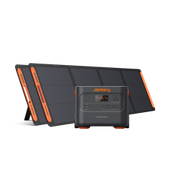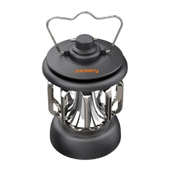Imagine it's a chilly winter month with temperatures just a couple of degrees below zero, and the power goes out. And now you're left wondering how to stay warm without power. Unexpected power outages can not only disrupt your daily life but can also be inconvenient, especially if electricity is the only source of heat and you don't have any other way to stay warm.
Thankfully, there are many simple ways to keep yourself warm, such as closing curtains at night, layering clothing, using bed warmers, and staying active. You can also consider investing in solar-powered generators like Jackery Solar Generators, which can charge heating appliances during power outages. For example, you can charge electric blankets, space heaters, bed warmers, etc., to stay warm in chilly winters.
Key Takeaways
- Some ways to stay warm without power include layering the clothing, closing curtains at night, using a solar generator, blocking drafts, and staying active.
- Some mistakes to avoid when staying warm during a power outage include starting open flames indoors, keeping windows and doors open, or using a gas generator indoors.
- A solar generator acts as one of the reliable emergency power supplies, keeping your heating appliances charged for hours during power outages.
How to Stay Warm Without Power
Winter storms, hurricanes, and natural disasters can lead to unexpected and long-term power outages. Freezing temperatures and power outages mean you need to find safe ways to stay warm and comfortable without electricity. Here's how to stay warm without power in winter:
Layer Your Clothing
One of the best ways to stay warm during a winter power outage is by layering the clothing and conserving body heat. You should start with thermal wear and then put on a warm shirt. You can top it off with a cardigan or sweater for added warmth.
Close Curtains At Night
Covering the curtains at night can help block out the windows and prevent unwanted chills from entering the room. You can also consider hanging throw blankets over the curtains for extra warmth.
Put the Generator Running
Generators act as a reliable backup source to charge heat-related appliances such as space heaters or electric blankets. Solar generators are eco-friendly charging solutions that can charge household appliances and ensure you stay warm for long hours.
Jackery Solar Generators are portable and powerful indoor generators that are enough to charge 99% of your appliances, such as space heaters and electric blankets. They are safe for indoor use and do not emit toxic fumes when charging electronics.

Use Electric Blankets or Sleeping Bags
Sleeping bags are considered for outdoor use, but they can be a great way to keep yourself warm without electricity. Using electric blankets or sleeping bags will ensure that body heat remains trapped, and you can stay comfortable throughout the power outage.
Block Drafts
Even if you diligently follow weatherstripping and caulking, your home can lose heat through gaps and leaks in windows and doors. A quick fix is to roll up towels or blankets or opt for draft stoppers and place them at the base of windows and doors to reduce drafts.
Stay Active
Engaging in light physical activities such as doing household chores or walking can generate internal body heat and get the blood pumping. Keeping your body active will ensure it generates more heat and makes you feel warmer.
Close Unused Rooms
There is no point in heating rooms that you don't use. Keeping doors and windows closed of unused rooms will prevent cold air from moving into the rest of the house.
Soapstone Heaters
Soapstone is one of the reliable heat absorbers, and it doesn't easily overheat. You can consider setting up a portable soapstone block next to any heat source, like a heater or stove. It will absorb the heat and radiate it back outwards for hours. Soapstone blocks also act as great bed warmers, especially for scenarios when you want to heat your home without electricity.
Fire Up the Fireplace
Firing up the fireplace is one of the simplest answers to how to stay warm in a house without power. Gas fireplaces with a battery backup for ignition will work even if there is no power. However, you should follow the safety precautions and keep flammable items away from the fireplace.
Camp Out Indoors
Camping inside your home is another great way to stay warm during power outages. A tent and sleeping bag can keep you warm and safe, especially at night when the temperature tends to drop.
Mistakes to Avoid When Staying Warm in Power Outage
When the power goes out in the chilly winter months, everyone starts looking for methods to stay warm. While it's pretty easy to panic and make hasty decisions, not all the methods are safe.
In fact, certain choices can put you at risk of injury, illness, or even fire. If you want to stay warm and safe without electricity, it's essential to avoid common mistakes that many people unknowingly make when preparing for a power outage.
Starting Open Flames Indoors
Lighting candles or using a fireplace without proper ventilation can lead to fire hazards and carbon monoxide buildup. While it might seem like a good way to stay warm, open flames are unpredictable, especially in closed spaces. Hence, it is better to choose battery-powered lanterns, flashlights, or LED lights for lighting or use safe alternative heat sources like a solar-powered generator.
Opening Windows and Doors
If there is no electricity in the winter months, you should not open the windows and doors. It can let out warm air and cool the indoor space. Hence, make sure to keep the windows, doors, or any other openings closed to retain heat. Try to cover the windows with bubble wrap or blankets to keep the cold out. In addition, you can use draft stoppers or towels to ensure no icy air comes from the bottom of the door.
Using a Gas Generator Indoors
You should not use a generator or gasoline-powered engine inside the home, garage, basement, or less than 20 feet from any vent, door, or window. Gas-powered generators emit toxic fumes or CO (carbon monoxide), which can be a threat to health and safety. Exposure to carbon monoxide can usually lead to loss of consciousness, headache, dizziness, vomiting, chest pain, and even death.
Solely Rely on Thick Clothing
It might look easy to throw on the thickest jacket you own, but what matters more is layering. You should start with thermal or moisture-wicking base layers and then add insulating middle and outer layers to block wind. This way, you can trap heat and keep yourself warmer for longer, especially when temperatures become chilly.
What to Do After Power Outages
Once the power is restored, there are a few simple steps you need to follow to get everything back to normal and be ready for the next outage. Many government websites, such as Ready.gov, Get Prepared, and the Red Cross, offer tips on how to safely return to normal life after a power outage.
Reconnect Electronics and Appliances
Before turning the main electric switch back on, make sure to turn off electric heaters, TVs, microwaves, and computers to ensure the power surge does not damage the appliances. If you unplugged the appliances before or during the power outage, make sure to plug them back in one at a time.
Dispose of Spoiled Food
Generally speaking, you should throw away any food that has been exposed to higher temperatures (4°C or 39.2°F) or has an unusual odor, texture, or color. If the power outage lasted more than a day, consider discarding any medication that should be refrigerated.
You should never taste food or rely on its appearance to determine its safety. Some foods might look good and smell fine, but they can cause bacteria-related and food-borne illnesses. In short, if you have doubts about a food item, it's better to throw it out.
Replenish the Emergency Kit
If you have prepared an emergency kit and used any of the stored water, food, or first aid supplies from the kit, consider replacing them for the next time. If you haven't yet built an emergency kit, it's better to do so. A little preparation to build an emergency kit and register for utility alerts will help you prepare for the next long-term power outage.
Store the Backup Power Safely
Since you will be using some sort of backup power source, make sure to refer to the manufacturer's instructions to safely store it. For example, if you have a diesel or gas generator, you need to either burn off the remaining fuel or drain it into an appropriate container. On the other hand, if you have used portable power stations or power banks during the power outage, make sure to recharge them before storing them so you are ready for the next outage.
Home Power Supply for Power Outages
Power outages can be inconvenient and a threat to health and safety. In extreme and unpredictable winter weather, the continuous usage of space heaters can push the limits of the electrical grid, leading to power outages or blackouts. That's where a home battery backup solution can help.
Jackery is a leading solar brand that manufactures highly efficient and portable solar generators, solar panels, and portable power stations. The extra backup power can keep your fridge running to ensure the food doesn't get spoiled and even keep medical devices like CPAP machines running for a peaceful sleep. It can also provide power for lights, space heaters, and blankets for added warmth.
Jackery Solar Generator 2000 Plus - Expandable Capacity for Growing Power Needs
The Jackery Solar Generator 2000 Plus is an expandable solar-powered generator that can charge 99% of your household appliances during long-term power outages.
Whether you want to charge a space heater to keep the room comfortable or wish to charge continuous power to the CPAP machine, the solar generator has got you covered!
It emits only 30dB of noise, which means it won't disturb your sleep in the winter months. And if you want to extend the battery capacity from 2kWh to a whopping 24kWh, all you need to do is connect the additional Jackery Battery Pack 2000 Plus.

Jackery Solar Generator 3000 Pro - Partial Home Backup Solution
The Jackery Solar Generator 3000 Pro is another battery backup for a home that can charge household appliances like space heaters, electric blankets, etc., during power outages.
It can charge 99% of your home appliances, such as lights, refrigerators, microwaves, electric stoves, etc., which makes the solar generator ideal for short—or long-term power outages.
The Jackery Manual Transfer Switch allows the solar generator to be easily connected to the home's electricity system, ensuring essential appliances like CPAP machines, refrigerators, and computers start powering up quickly.

|
Products |
Appliances Running Time |
|
Jackery Solar Generator 2000 Plus |
|
|
Jackery Solar Generator 3000 Pro |
|
FAQs to Stay Warm Without Power
How do you stay warm when the power is out?
If you want to stay warm during a power outage, you should consider dressing in layers of warm clothing, using sleeping bags and electric blankets, and closing curtains to conserve indoor heat. You can also consider using a solar-powered indoor generator that can charge heating appliances for hours.
How can I get heat without electricity?
A solar generator is one safe and eco-friendly solution for charging heating appliances during a power outage. Jackery offers a wide range of solar-powered generators that can keep space heaters running during a blackout.
How do you heat when there is no power?
When there is no power, you can keep the indoor space warm with alternative methods like a fireplace or wood stove or by ensuring proper insulation to retain heat. If possible, you should consider investing in a solar generator to charge space heaters or electric blankets to keep your home warm.
How can I keep warm without heating or electricity?
You should consider layering your clothing, using thick curtains to trap sunlight's heat, wearing warm socks and gloves to conserve body heat, and using hot water bottles in bed. You can also generate your own body heat by staying active.
Conclusion
When temperatures become extremely cold, power outages can become an emergency situation. Hence, understanding how to stay warm without power will help you keep yourself and your family safe. While dressing in layers or closing curtains can help stay warm to some extent, it might not be a viable solution in every scenario.
For example, if you or a family member rely on medical equipment like CPAP machines or the temperature reaches beyond bearable, you need to consider a solar generator. Jackery Solar Generator is a robust and reliable charging solution that can power a wide range of household appliances so you can stay safe and warm in power outages.
What methods do you usually use to stay warm during a power outage? Share your thoughts in the comment section below!




















































































































Leave a comment